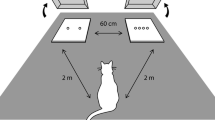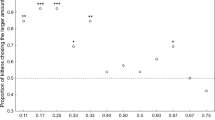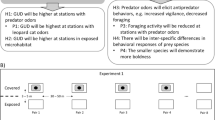Abstract
Quantity discrimination is of adaptive relevance in a wide range of contexts and across a wide range of species. Trained domestic cats can discriminate between different numbers of dots, and we have shown that they also spontaneously choose between different numbers and sizes of food balls. In the present study we performed two experiments with 24 adult cats to investigate spontaneous quantity discrimination in the more naturalistic context of potential predation. In Experiment 1 we presented each cat with the simultaneous choice between a different number of live prey (1 white mouse vs. 3 white mice), and in Experiment 2 with the simultaneous choice between live prey of different size (1 white mouse vs. 1 white rat). We repeated each experiment six times across 6 weeks, testing half the cats first in Experiment 1 and then in Experiment 2, and the other half in the reverse order. In Experiment 1 the cats more often chose the larger number of small prey (3 mice), and in Experiment 2, more often the small size prey (a mouse). They also showed repeatable individual differences in the choices which they made and in the performance of associated predation-like behaviours. We conclude that domestic cats spontaneously discriminate between the number and size of potential prey in a way that can be interpreted as adaptive for a lone-hunting, obligate carnivore, and show complex levels of risk–reward analysis.




Similar content being viewed by others
References
Adamec RE (1976) The interaction of hunger and preying in the domestic cat (Felis catus): an adaptive hierarchy? Behav Biol 18:263–272. https://doi.org/10.1016/S0091-6773(76)92166-0
Adamec RE, Stark-Adamec C, Livingston KE (1980) The development of predatory aggression and defense in the domestic cat (Felis catus): I. Effects of early experience on adult patterns of aggression and defense. Behav Neural Biol 30:389–409. https://doi.org/10.1016/S0163-1047(80)91256-X
Agrillo C, Bisazza A (2014) Spontaneous versus trained numerical abilities. A comparison between the two main tools to study numerical competence in non-human animals. J Neurosci Methods 234:82–91. https://doi.org/10.1016/j.jneumeth.2014.04.027
Avery MI, Krebs JR (1984) Temperature and foraging success of great tits Parus major hunting for spiders. Ibis 126:33–38. https://doi.org/10.1111/j.1474-919X.1984.tb03661.x
Baker PJ, Bentley AJ, Ansell RJ, Harris S (2005) Impact of predation by domestic cats Felis catus in an urban area. Mammal Rev 35:302–312. https://doi.org/10.1111/j.1365-2907.2005.00071.x
Bánszegi O, Urrutia A, Szenczi P, Hudson R (2016) More or less: spontaneous quantity discrimination in the domestic cat. Anim Cogn 19:879–888. https://doi.org/10.1007/s10071-016-0985-2
Benson-Amram S, Gilfillan G, McComb K (2018) Numerical assessment in the wild: insights from social carnivores. Philos Trans R Soc Lond B Biol Sci 373:20160508. https://doi.org/10.1098/rstb.2016.0508
Biben M (1979) Predation and predatory play behaviour of domestic cats. Anim Behav 27:81–94. https://doi.org/10.1016/0003-3472(79)90129-5
Biró Z, Lanszki J, Szemethy L, Heltai M, Randi E (2005) Feeding habits of feral domestic cats (Felis catus), wild cats (Felis silvestris) and their hybrids: trophic niche overlap among cat groups in Hungary. J Zool 266:187–196. https://doi.org/10.1017/S0952836905006771
Bonnaud E, Bourgeois K, Vidal E, Kayser Y, Tranchant Y, Legrand J (2007) Feeding ecology of a feral cat population on a small Mediterranean island. J Mammal 88:1074–1081. https://doi.org/10.1644/06-MAMM-A-031R2.1
Bradshaw JWS (2006) The evolutionary basis for the feeding behavior of domestic dogs (Canis familiaris) and cats (Felis catus). J Nutr 136:1927S–1931S. https://doi.org/10.1093/jn/136.7.1927S
Bradshaw JWS, Goodwin D, Legrand-Defretin V, Nott HMR (1996) Food selection by the domestic cat, an obligate carnivore. Comp Biochem Physiol A Physiol 114:205–209. https://doi.org/10.1016/0300-9629(95)02133-7
Carere C, Locurto C (2011) Interaction between animal personality and animal cognition. Curr Zool 57:491–498. https://doi.org/10.1093/czoolo/57.4.491
Caro TM (1980a) The effects of experience on the predatory patterns of cats. Behav Neural Biol 29:1–28. https://doi.org/10.1016/S0163-1047(80)92442-5
Caro TM (1980b) Effects of the mother, object play, and adult experience on predation in cats. Behav Neural Biol 29:29–51. https://doi.org/10.1016/S0163-1047(80)92456-5
Childs JE (1986) Size-dependent predation on rats (Rattus norvegicus) by house cats (Felis catus) in an urban setting. J Mammal 67:196–199. https://doi.org/10.2307/1381025
Christian DP (1975) Vulnerability of meadow voles, Microtus pennsylvanicus, to predation by domestic cats. Am Midl Nat 93:498–502. https://doi.org/10.2307/2424189
Cooper AB, Pettorelli N, Durant SM (2007) Large carnivore menus: factors affecting hunting decisions by cheetahs in the Serengeti. Anim Behav 73:651–659. https://doi.org/10.1016/j.anbehav.2006.06.013
Crowell-Davis SL, Curtis TM, Knowles RJ (2004) Social organization in the cat: a modern understanding. J Feline Med Surg 6:19–28. https://doi.org/10.1016/j.jfms.2003.09.013
Gamer M, Lemon J, Singh IFP (2012) IRR: various coefficients of interrater reliability and agreement. version: 0.84. https://CRAN.R-project.org/package=irr
González D, Szenczi P, Bánszegi O, Hudson R (2018) Testing aggressive behaviour in a feeding context: importance of ethologically relevant stimuli. Behav Processes 150:1–7. https://doi.org/10.1016/j.beproc.2018.02.011
Halekoh U, Højsgaard S, Yan J (2006) The R package geepack for generalized estimating equations. J Stat Softw 15:1–11
Hudson R, Rangassamy M, Saldaña A, Bánszegi O, Rödel HG (2015) Stable individual differences in separation calls during early development in cats and mice. Front Zool 12:S12. https://doi.org/10.1186/1742-9994-12-S1-S12
Jeschke JM, Tollrian R (2007) Prey swarming: which predators become confused and why? Anim Behav 74:387–393. https://doi.org/10.1016/j.anbehav.2006.08.020
Krusche P, Uller C, Dicke U (2010) Quantity discrimination in salamanders. J Exp Biol 213:1822–1828. https://doi.org/10.1242/jeb.039297
Kutt AS (2012) Feral cat (Felis catus) prey size and selectivity in north-eastern Australia: implications for mammal conservation. J Zool 287:292–300. https://doi.org/10.1111/j.1469-7998.2012.00915.x
Lanszki J, Kletečki E, Trócsányi B, Mužinić J, Széles GL, Purger JJ (2015) Feeding habits of house and feral cats (Felis catus) on small Adriatic islands (Croatia). Northwest J Zool 12:336–348
Liberg O (1984) Food habits and prey impact by feral and house-based domestic cats in a rural area in southern Sweden. J Mammal 65:424–432. https://doi.org/10.2307/1381089
Mendl M, Harcourt R (2000) Individuality in the domestic cat: origins, development and stability. In: Turner DC, Bateson P (eds) The domestic cat: the biology of its behaviour, 2nd edn. Cambridge University Press, Cambridge, pp 179–190
Nieder A (2018) Evolution of cognitive and neural solutions enabling numerosity judgements: lessons from primates and corvids. Philos Trans R Soc Lond B Biol Sci 373:20160514. https://doi.org/10.1098/rstb.2016.0514
Panteleeva S, Reznikova Z, Vygonyailova O (2013) Quantity judgments in the context of risk/reward decision making in striped field mice: first “count”, then hunt. Front Physiol 4:45–51. https://doi.org/10.3389/fpsyg.2013.00053
Pearre S Jr, Maass R (1998) Trends in the prey size-based trophic niches of feral and house cats Felis catus L. Mammal Rev 28:125–139. https://doi.org/10.1046/j.1365-2907.1998.00030.x
Pellis SM, O'Brien DP, Pellis VC, Teitelbaum P, Wolgin DL, Kennedy S (1988) Escalation of feline predation along a gradient from avoidance through "play" to killing. Behav Neurosci 102:760. https://doi.org/10.1037/0735-7044.102.5.760
Péter A (2017) Solomon Coder: a simple solution for behavior coding. version: beta 17.02.15. https://solomoncoder.com/
Pisa PE, Agrillo C (2009) Quantity discrimination in felines: a preliminary investigation of the domestic cat (Felis silvestris catus). J Ethol 27:289–293. https://doi.org/10.1007/s10164-008-0121-0
R Core Team (2018) R: A language and environment for statistical computing. version: 3.5.1. Vienna. www.R-project.org.
Skorupski P, MaBouDi H, Galpayage Dona HS, Chittka L (2018) Counting insects. Philos Trans R Soc Lond B Biol Sci 373:20160513. https://doi.org/10.1098/rstb.2016.0513
Spotte S (2014) Free-ranging cats: behavior, ecology, management, 1st edn. Wiley, Chichester
Stancher G, Rugani R, Regolin L, Vallortigara G (2015) Numerical discrimination by frogs (Bombina orientalis). Anim Cogn 18:219–229. https://doi.org/10.1007/s10071-014-0791-7
Stanton LA, Sullivan MS, Fazio JM (2015) A standardized ethogram for the felidae: a tool for behavioral researchers. Appl Anim Behav Sci 173:3–16. https://doi.org/10.1016/j.applanim.2015.04.001
Stella JL, Buffington CAT (2013) Individual and environmental effects on health and welfare. In: Turner DC, Bateson P (eds) The domestic cat: the biology of its behaviour, 3rd edn. Cambridge University Press, Cambridge, pp 185–200
Stoffel MA, Nakagawa S, Schielzeth H (2017) rptR: repeatability estimation and variance decomposition by generalized linear mixed-effects models. Methods Ecol Evol 8:1639–1644. https://doi.org/10.1111/2041-210x.12797
Sunquist ME, Sunquist FC (1989) Ecological constraints on predation by large felids. In: Gittleman JL (ed) Carnivore behavior, ecology, and evolution. Springer, Boston, pp 283–301. doi:10.1007/978–1–4757–4716–4_11
Széles GL, Purger JJ, Molnár T, Lanszki J (2018) Comparative analysis of the diet of feral and house cats and wildcat in Europe. Mammal Res 63:43–53. https://doi.org/10.1007/s13364-017-0341-1
Tobie C, Péron F, Larose C (2015) Assessing food preferences in dogs and cats: a review of the current methods. Animals 5:126–137. https://doi.org/10.3390/ani5010126
Turner DC, Meister O (1988) Hunting behaviour of the domestic cat. In: Turner DC, Bateson P (eds) The domestic cat: the biology of its behaviour, 1st edn. Cambridge Press University, Cambridge, pp 111–121
Uller C, Jaeger R, Guidry G, Martin C (2003) Salamanders (Plethodon cinereus) go for more: rudiments of number in an amphibian. Anim Cogn 6:105–112. https://doi.org/10.1007/s10071-003-0167-x
Urrutia A, Martínez-Byer S, Szenczi P, Hudson R, Bánszegi O (2019) Stable individual differences in vocalisation and motor activity during acute stress in the domestic cat. Behav Processes 165:58–65. https://doi.org/10.1016/j.beproc.2019.05.022
van Orsdol KG (1984) Foraging behaviour and hunting success of lions in Queen Elizabeth National Park, Uganda. Afr J Eco 22:79–99. https://doi.org/10.1111/j.1365-2028.1984.tb00682.x
Wang Q, Liu D, Holyoak M, Jia T, Yang S, Liu X, Kong X, Jiang G (2019) Innate preference for native prey and personality implications in captive amur tigers. Appl Anim Behav Sci 210:95–102. https://doi.org/10.1016/j.applanim.2018.10.006
Werner EE, Hall DJ (1974) Optimal foraging and the size selection of prey by the bluegill sunfish (Lepomis macrochirus). Ecology 55:1042–1052. https://doi.org/10.2307/1940354
Acknowledgements
Financial support was provided by the Dirección General de Asuntos del Personal Académico, Universidad Nacional Autónoma de México (DGAPA, Grant number IN212416), by a grant to O. B. from the Instituto de Investigaciones Biomédicas, Universidad Nacional Autónoma de México, and by a Cátedra grant to P. S. from the Consejo Nacional de Ciencia y Tecnología, México (CONACyT, Grant number 691). J. C. and D. G. received postgraduate fellowships from CONACyT (Grant numbers 796846 and 29246, respectively), and they thank the Posgrado en Ciencias Biológicas, UNAM for its support. We thank Carolina Rojas for excellent technical and bibliographical assistance, and cat owners (Alicia Aguilar, Adriana Carrillo, Javier Chang, Rafael Hernández, Eduardo Leyva, Josué Monroy, Guadalupe Nava, Pedro Ramón, Sonia Salum, and Lorena Vargas) for allowing us repeated access to their homes and cats.
Author information
Authors and Affiliations
Corresponding authors
Ethics declarations
Conflict of interest
The authors declare that they have no conflict of interest.
Ethics approval
All applicable international and/or institutional guidelines for the care and use of animals were followed. Throughout the study, animals were kept and treated according to the Guide for the Production, Care and Use of Laboratory Animals, Mexico (Norma Oficial Mexicana NO-062-200-1999), and with approval by the Institutional Committee for the Care and Use of Laboratory Animals (CICUAL, permission ID 6303) of the Institute of Biomedical Research, UNAM. This article does not contain any studies with human participants performed by any of the authors.
Additional information
Publisher's Note
Springer Nature remains neutral with regard to jurisdictional claims in published maps and institutional affiliations.
Electronic supplementary material
Below is the link to the electronic supplementary material.
Rights and permissions
About this article
Cite this article
Chacha, J., Szenczi, P., González, D. et al. Revisiting more or less: influence of numerosity and size on potential prey choice in the domestic cat. Anim Cogn 23, 491–501 (2020). https://doi.org/10.1007/s10071-020-01351-w
Received:
Revised:
Accepted:
Published:
Issue Date:
DOI: https://doi.org/10.1007/s10071-020-01351-w




